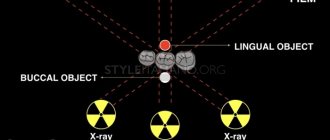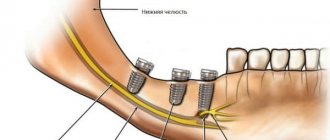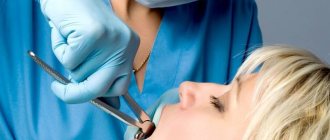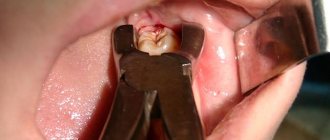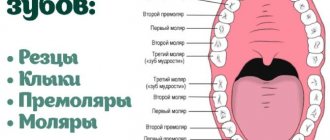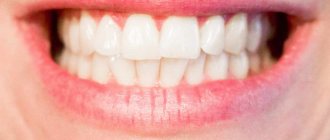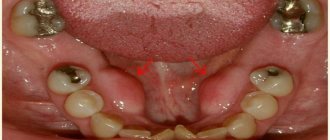Number of roots in human teeth
Modern dentistry has introduced new words “endodontics” and “endodontist” into common use.
Endodontics is a branch of modern dentistry that studies the structure, functions and diseases of the tissues and structures inside the tooth. An endodontist is a specialist in the field of dentistry who is able to cope with diseases of these same tissues and structures. The main task of endodontics is the treatment and preservation of teeth with damaged, unhealthy pulp. To understand how difficult it is for such a specialist to work, you need to understand a little the anatomical structure of the tooth. After all, the whole difficulty of such treatment lies in the fact that the dentist is limited in visual control.
Each tooth has a crown and a root, and many posterior teeth have two or three roots that contain root canals. The outside of the tooth crown is covered with enamel - this is the hardest tissue of the human body that reliably protects the tooth. Beneath the enamel is a less hard and porous tissue called dentin, which surrounds the tooth cavity in which the pulp is located.
The pulp contains nerve fibers and blood vessels that enter the tooth from the bone, from the main apical foramen and numerous small holes through which the root canal communicates with blood and lymph. The pulp is involved in the formation of the tooth, but after this process is completed, the enamel and dentin no longer need nutrition, so a tooth with the pulp removed can serve a person throughout his life, subject to high-quality endodontic treatment.
You can see the number of root canals in each tooth in the table below.
| Teeth | Average tooth length (mm.) | Number of roots | Number of channels | Specific Features |
| Upper central incisor | 23 | 1 (100%) | 1 (100%) | 1. Lateral canals infrequently 2. Apical delta often 3. Cervical narrowing |
| Upper lateral incisor | 22 | 1 (99.9%) | 1 (99.9%) | 1. Lateral canals infrequently 2. Apical delta often 3. The apical part of the root is often curved palatally. |
| Upper canine | 27 | 1 (99.9%) | 1 (99.9%) | 1. Lateral canals infrequently 2. Apical delta infrequently |
| Upper first premolar | 21 | 1 (19%) 2 (80%) 3 (1%) | 1(4%) 2 (95%) 3 (1%) | 1. Lateral canals infrequently 2. Apical delta infrequently 3. Concavity on the mesial surface of the root |
| Upper second premolar | 22 | 1 (90%) 2 (9%) 3 (1%) | 1 (75%) 2 (24%) 3 (1%) | 1. Lateral canals infrequently 2. Apical delta infrequently |
| Upper first molar | 21 | 2 (15%) 3 (85%) | 3 (60%) 4 (40%) | 1. Lateral canals infrequently 2. Apical delta infrequently 3. Mesicobuccal root of the 2nd canal in 40% |
| Upper second molar | 20 | 1 (1%) 2 (19%) 3(80%) | 1(1%) 2 (2%) 3 (57%) 4 (40%) | 1. Lateral canals infrequently 2. Apical delta infrequently 3. Mesicobuccal root of the 2nd canal in 40% |
| Lower incisors | 21-22 | 1 (100%) | 1 (60%) 2 (40%) | 1. Lateral canals infrequently 2. Apical delta infrequently |
| Bottom click | 26 | 1 (98%) 2 (2%) | 1 (94%) 2 (2%) | 1. Lateral canals infrequently 2. Apical delta infrequently |
| Lower first premolar | 22 | 1 (100%) | 1 (75%) 2 (20%) 3 (5%) | 1. Lateral canals infrequently 2. Apical delta infrequently 3. Lingual inclination 4. Second canal 15% |
| Lower second premolar | 22 | 1 (100%) | 1 (89%) 2 (10%) 3 (1%) | 1. Lateral canals infrequently 2. Apical delta infrequently |
| Lower first molar | 21 | 2 (98%) 3 (2%) | 2(13%) 3 (80%) 4 (7%) | 1. Lateral canals in the bifurcation area 2. Apical delta often in the mesial root 3. Mesial root - in 13% only one canal 4. Distal root - in 7% 2 canals |
| Lower second molar | 20 | 3(1%) 2 (84%) 1 (15%) | 4 (7%) 3 (77%) 2 (13%) 1 (3%) | 1. Lateral canals in the bifurcation area 2. Apical delta often in the mesial root 3. Mesial root - in 13% only one canal 4. Distal root - in 7% 2 canals |
The roots of teeth can have a complex anatomical shape, which significantly complicates endodontic treatment. For high-quality endodontic treatment, a dentist must use high-quality rotary instruments and modern materials for performing root canals.
Each of us at least once asked ourselves questions about what the cavity of a molar is, how many roots and canals there are in it. What is their topography and anatomy? How many nerves are there in the cavity of the molar located on top, and how many in the one on the bottom? Working length of the root canal - what is it?
In dentistry, since 1971, there has been the so-called two-digit Viola system. According to it, the units of the upper and lower jaw of a person are divided into four quadrants, each of which has 8 teeth. Quadrants for adults are numbered as 1, 2, 3 and 4, and for children - numbers from 5 to 8 (see table). Therefore, if you suddenly hear from a dentist that you are undergoing medicinal root canal treatment of 46 or 36 units, do not be alarmed.
Each unit has its own individual structure. The number of canals and roots depends on where it is located and what function it performs. From this article you will learn what a dental cavity is and why it is affected by pulpitis. Also read about the concept of working length of the root canal. You will learn about methods for expanding dental cavities and their medicinal treatment, and see photos of three-channel pulpitis.
The number of channels differs from the number of root bases. The cavities of teeth such as incisors can have one, two or three canals. In order to accurately determine the number of these dental canals and their location, the doctor takes an x-ray of the patient. It helps him carry out the procedure of opening the tooth cavity more accurately.
Let's take a closer look at how many canals and roots there are in each cavity. What are the differences in their numbers on the upper and lower jaws?
On the upper jaw
According to the special dental numbering system for root teeth, their counting begins with the central incisors. The upper units, which are numbered from one to five, have one root each, 6, 7 and 8 have three roots.
The most current types of haircuts under 3 mm
Despite the ultra-short length, men's hairstyle under 3 has several varieties that differ in execution technique.
Boxing and semi-boxing
This type of three-piece haircut has the following features:
- the temples and back are shaved to zero, the central crown is shaved to 3 mm;
- zonal transitions are clear, without smoothness;
- boxing implies a short length, half-boxing is longer options.
How to make a men's boxing or semi-boxing three-piece haircut:
- Using a nozzle with a length of 3 mm, treat the entire head. It is important to ensure that the length of the hair is the same over the entire surface;
- determine the line where the edging will go. Below this line, you need to treat the surface with a machine, choosing the minimum nozzle - number 1;
- shorten the bangs to the desired length;
- if necessary, thin out the central zone with scissors.
Tennis
Men's three-piece tennis haircut is very popular among young people. It is suitable for those with coarse hair that is difficult to style. To perform a tennis haircut, you need to treat your head with a clipper with nozzle number 4 or 6. Then determine the edging line. Change the nozzle to a three-piece and make a smooth transition from the edging line - moving the machine from the bottom line to the top of the head.
Princeton
The peculiarity is in the elongated strands on the crown area, which can be styled in various ways - combed back, combed to the side, lifted up and other options. The length of hair on the crown area is 3-6 mm. The sides and back of the head are processed at 2-3 mm with a mandatory smooth transition from short (under three) strands to longer (under 6).
Bobrik
Beaver is a men's haircut that resembles a playground or a crew cut. The only difference is that the difference between the shortest hair and the longest is 3-6 mm. It does not require bangs and requires styling - the central part is usually placed vertically and slightly on its side.
Army
A men's military-style three-piece haircut is easy to do - just two attachments 91 and 3 mm are enough). The sides and back of the head are treated first, and the crown and bangs are made into a three-piece. The machine is moved from the top of the head to the forehead.
Advice : brutal men who have begun to notice that their hair is thinning should choose a military style in their hairstyles.
Canadian
The main feature of Canada is the presence of clear boundaries between zones. The master leaves elongated hair on the top of the head. When performed independently, the lateral areas and the occipital area are treated with nozzle No. 3. A longer length is left on the top of the head (optional) - 5, 6, 8 or more millimeters (at the guy’s request).
Shaved temples with patterns
The emergence of new types of clippers has allowed hairdressers to offer an interesting service in men's haircuts - patterns on the short-shaved surface. A three-piece or two-piece haircut is optimal for this. To begin with, the head is treated with a 3 mm nozzle. You can leave long hair on the top of your head to allow for creative styling.
Then a contour is drawn on the shaved surface. It is better to start with simple lines - stripes, small waves. If things don’t work out, you can always shave such areas with a 1 mm nozzle.
Caesar
Features of a men's three-piece Caesar haircut:
- short sides and back of the head (nozzle No. 3 is suitable);
- elongated central part;
- straight short bangs;
- clear borders.
Blitz
Men's blitz haircut under three (or 6) is performed on the basis of another hairstyle - a platform.
How to do:
- the lower occipital part is cut to zero;
- distribution zone - shading (length smoothing) is carried out along vertical lines;
- the areas of the temples and behind the ears are shaved to a single;
- along the forehead line, a strand is isolated and combed onto the forehead - about 1 cm wide;
- A control strand is identified along the central parting and vertical line. Determine its height (3-6 mm) and trim it;
- the entire area of the crown is processed according to the model of the selected strand;
The blitz haircut is carefully extinguished with a three-piece nozzle. The control frontal strand is formed using a razor - you can create a slight asymmetry.
Below zero
This men's haircut has long been associated with the criminal world, prisoners and military recruits. Currently, it is popular among athletes and ordinary young people. This option is suitable for men with a round skull, a beautiful medium-sized forehead, and clear skin. To perform a haircut, use a unit. She needs to work carefully so as not to damage the delicate skin. If such a men's haircut seems very radical, you can use a three-piece, treating the entire surface of the head without transitions.
Hedgehog
A distinctive feature of the hedgehog is the vertical hair on the crown of the head. A men's crew cut is suitable for those guys who have naturally coarse hair that needs to be “tamed.” How to do:
- Using the minimum nozzle (No1), remove hair from the back and sides of the head. Focus on the intended edging line;
- they design the crown transition - smooth. Three are used.
Advice : to make the transition from a short length (under three) to a longer one smooth and even, when processing the nozzle is slightly moved away from the surface of the head.
How many canals are there in the upper and lower teeth?
Correctly determining the number of canals in a tooth is only possible using an x-ray. Of course, their number depends on where the tooth is located - with a greater chewing load on the teeth in the back of the jaws, the retaining system is stronger; accordingly, they are larger, have more roots and canals. However, this is not a constant indicator, and it does not mean that the upper or lower incisors will have only one canal; it all depends on the individual characteristics of the jaw structure of each person. Therefore, how many canals in a diseased tooth require filling can be determined by the dentist during an autopsy or with the help of an x-ray.
Methods of maxillary six implantation
Molar implantation is performed using two methods.
- One-stage ( with immediate loading ) - allows you to restore a lost tooth in 4-5 days.
- Two-stage ( classical delayed load method ). The most common. Its main advantage is complete osseointegration of the implant at the time of prosthetics.
To restore the 6th tooth, two-stage implantation is most often used, which allows the artificial root to completely take root. This process can take from 3 to 6 months.
Interest calculation
Due to the fact that each person is individual and there are no clear norms and rules for determining how many canals are in the teeth, in dentistry data on this issue are given as a percentage. Initially, they are repelled by the fact that the same teeth of the upper and lower jaws are very different from each other. If the first three upper incisors in almost one hundred percent of cases have only one canal, then with the same teeth of the lower jaw everything is much more complicated, and they have approximately the following percentage ratio:
- In the first incisor, most often there is only one canal - this is in 70% of cases from the general statistics, and only in 30% there can be two of them;
- The second tooth can have either one or two canals in almost equal proportions, or more precisely, a ratio of 56% to 44%;
- The third incisor of the lower jaw almost always has only one canal, and only in 6% of cases can there be two.
Premolars have a larger structure, more pressure and load are already placed on them, so it is logical to assume that there are more canals in the tooth, however, not everything is so simple here. For example, in the fourth tooth of the upper jaw, only 9% of teeth actually have one canal , in 6% of cases there may even be three, but the rest most often have two. But at the same time, the next premolar (fifth tooth), which seems to bear an even stronger load, most often has one canal and only in some cases more (of which only 1% is accounted for by three branches).
At the same time, in the lower jaw the situation is completely different - the first and second premolars are not three-canal at all, but most often have only one canal (74% - four and 89% - five) and in only 26% of cases for four and 11% for five - two.
The molars are already larger and the number of canals is increasing. The sixes of the upper jaw can have either three or four branches with equal probability. On the lower jaw, a two-canal tooth can sometimes be found (usually no more than 6% of cases), but most often there are three canals (65%) and sometimes four.
Posterior molars usually have the following relationship:
- Top seven: 70 to 30% three and four channels;
- Bottom seven: 13 to 77% two and three channels.
Why is the warranty period different for the manufacturer and the clinic?
Dentists cannot give a 100% guarantee of successful implantation, since there is always some risk. Clinics provide a guarantee of only 1-2 years. While the manufacturers' warranty for the service life of implants can range from 10 years to a lifetime .
Rejection due to defective rods is rare. Most often due to the fault of the dentist or patient, which is detected very quickly - from 2 weeks to 6 months. In rare cases, rejection is possible after several years, but this is due to poor oral hygiene or deterioration of the patient’s health.
Wisdom tooth
The figure eight or wisdom tooth is quite unique and does not fall under standards and statistics.
The upper one can have a completely different structure with channels from one to five. The lower eight is most often found to be three-channel, however, often upon opening during treatment additional branches may be discovered. Among other things, a wisdom tooth differs from others in that its canals are rarely of the correct shape, often very curved and with a narrow passage, which greatly complicates their treatment and filling.
Features of a 6 mm haircut
Men's three-piece hairstyle is the easiest option if you have a clipper. It's hard to make mistakes here. A hairstyle under 6 is performed when it is necessary to create a sharp contrast between ultra-short hair and longer hair. As a rule, nozzle 6 is used to treat the upper part of the head. You need to work with it carefully, but if necessary, unsuccessful areas can be corrected with a smaller nozzle number.
Misconception
Since a tooth consists of roots and a pre-crown part, there is sometimes a misconception that there are as many canals in teeth as there are roots . This is far from true, because the canals quite often branch and bifurcate near the pulp. Moreover, several channels can run parallel to each other in one root. There are also cases of their bifurcation at the apex, which means that one root has two apices and this, of course, complicates the work of doctors when filling such teeth.
Taking into account all the features of the individual structure of teeth, dentists need to be very careful when treating and filling, so as not to miss any branch. After all, sometimes without an x-ray it is very difficult, even during an autopsy, to identify how many canals there are in the teeth.
Who is suitable for 3 mm and 6 mm haircuts?
Stylists and hairdressers advise men to pay attention to the men's three-piece hairstyle:
- athletes or those leading an active lifestyle, often traveling on business;
- those with masculine facial features and square chins;
- with a strong willed character;
- with an even skull shape, ideal scalp;
- who do not have imperfections in appearance - scars, irritations on the facial skin.
Men's hairstyle under 6 is suitable for guys:
- those who prefer business or casual clothing;
- who know how to take care of hair;
- not afraid of the need for daily hair styling;
- those who do not want an ultra-short length over the entire head (the crown is designed under 6);
- with a beard and mustache.
Treatment
The development of modern medicine and dentistry in particular, today makes it possible to increasingly preserve those diseased teeth that just yesterday had to be removed due to the impossibility of treatment. The procedure for treating root canals in teeth is itself quite complex, because they are filled with soft tissue - pulp, which contains a large number of nerve endings, blood vessels and other connective tissues.
Today, this is dealt with by a separate branch of dentistry – endodontics, the development of which makes it possible to improve the condition of a person’s teeth and cure even complex problems in more than 80% of cases, preserving the tooth itself. The goals of this treatment are:
- Removing developing infection inside the root system;
- Preventing pulp decay or removing it;
- Removal of infected dentin;
- Preparing the canal for filling (giving it the desired shape);
- Increasing the effect of medications.
The difficulty of such treatment of the root system is that it is quite difficult for the dentist to get to the diseased canals and control the progress of the procedure. After all, if you do not remove even a microscopic part of the infection, it can develop again over time.
Haircut under 3 mm - main features
A 3 mm men's haircut is a universal option that will suit almost any young man. Previously, men's haircuts of 3 mm were used for military personnel, geologists and other professions associated with long business trips and charter requirements. In such conditions, it is difficult to care for hair lengths longer than 3 mm. In addition, such a men's haircut made it possible to comply with hygienic requirements.
In the 21st century, three-piece haircuts can be found on the pages of fashion magazines, the covers of which often feature famous athletes, film actors and musicians. Naturally, they cut their hair in a three-piece not for reasons of hygiene, but based on fashion trends.
Process and stages of root canal treatment
The root canal treatment process has a clear sequence of stages:
- Initially, it is necessary to correctly diagnose the disease. In difficult cases, the dentist sends the patient for an x-ray.
- After this, the doctor carries out the necessary preparatory procedures in the oral cavity for treatment.
- Canal treatment is a rather painful procedure, so the tooth must be numbed by injecting anesthesia (usually into the gum near the diseased tooth).
- After this, complete asepsis of all instruments is carried out and the diseased tooth is separated from the rest using a special rubber film (caffedram).
- Next, the diseased tooth is opened using a drill, providing maximum access to the diseased canals, after which they are initially cleaned, the infected pulp is removed, and in parallel the canals are treated with special medications.
- Afterwards I dry them and seal them with special materials.
If the doctor has any doubts (usually this happens when the tooth is inconveniently positioned and instruments have difficulty accessing it), he puts a temporary filling , after which he sends the patient for an x-ray, using a photo of which he checks whether all the infection has been removed and whether all the canals have been removed. cleaned it. The permanent filling is then placed approximately two weeks later.
This whole procedure, of course, is not very pleasant, but it allows you to save the tooth. Its duration depends on the location of the tooth, the number of canals in it, the complexity of the developed infection and usually takes from thirty minutes to one hour. And success depends on the professionalism of the doctor and the high-quality work he has done, since it is necessary to remove all the affected pulp from the canals without leaving a drop of infection, otherwise it can develop again and tightly seal the tooth so that nothing else can get into the cleaned cavity.
Tips for using the machine
- It is better to treat dry hair, but first you need to wash and dry it;
- before using the attachment (3 or 6), you can cut your hair with scissors;
- start working with the machine from the parietal region;
- when processing the back of the head, the machine is placed perpendicular to the surface of the head and moved smoothly;
- treatment of temples - movement of the nozzle (6 or 3) against hair growth;
- When choosing a men's hairstyle for a three or six, the edging is oval or trapezoidal.
Prevention after treatment
After the root system treatment procedure, you should avoid putting stress on the treated tooth for some time; moreover, you should not eat food earlier than two hours after the therapy, otherwise the filling, which is not completely hardened, may simply fall out.
However, the same thing can happen if the doctor uses low-quality drugs or carries out incorrect treatment (for example, the canals are over-dried or not dried before filling). Also, after filling, for some time (up to several days) the tooth may be painful when pressed or simply ache, cause discomfort, and have increased sensitivity. This is usually normal, but if the pain is severe, you can take painkillers. If the pain does not go away after a certain time, this may also be an indicator of poor treatment (insufficient cleaning of the infection or infected pulp, leaky filling, use of low-quality drugs or materials).
Sometimes there are cases of allergic reactions , which are also accompanied by incessant pain, sometimes itching and rashes appear on the body. It may be caused by a reaction to the drug or the material that was used for the filling. In this case, it must be replaced with another one that will not cause allergies.
In all these situations, it is imperative to consult a doctor as soon as possible for a re-examination and dental prophylaxis in order to identify the cause of deviations from the norm.
